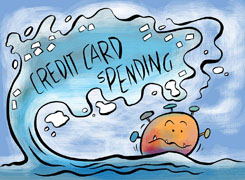Dear sir, I am earning salary of 40k per month I am 28 years old, I am having personal loan outstanding of 3.6lakhs with remaining tenure 24 months and credit card bills of 8 lakhs, I am not able to manage to pay credit card bills currently what steps should and how should I come out of this financial problem and I don't have any other liabilities and any investments
Ans: You are 28 years old with a salary of Rs 40,000 per month.
You have a personal loan of Rs 3.6 lakhs.
You also have credit card outstanding of Rs 8 lakhs.
You do not have any investments or other liabilities.
This situation feels stressful. But with right action, you can come out of it.
Let us now look at your issue from a 360-degree view.
1. Understanding Your Debt Structure
You are carrying two kinds of loans — personal and credit card.
Personal loan is structured. Fixed EMI and tenure.
Credit card dues are open-ended. Interest is very high.
Personal loan interest is about 12–15% usually.
Credit card interest is 36–48% yearly. This is extremely expensive.
The interest keeps increasing monthly if not paid in full.
Credit card debt is unmanageable if not controlled quickly.
Currently, your highest priority is credit card repayment.
Focus on reducing credit card debt first, not personal loan.
But you cannot ignore personal loan EMI also.
So balance is needed between the two.
Understand your total monthly repayment capacity.
This is the starting point of your recovery.
2. Analyse Your Monthly Budget in Detail
Your salary is Rs 40,000. First track all monthly expenses.
Write down every rupee spent — rent, food, transport, recharge.
Identify non-essential spending — like online shopping, food delivery, OTT.
Stop or pause all non-essential expenses immediately.
Keep expenses only for basic needs and EMIs.
Create a lean budget. Stay strict for next 24 months.
This sacrifice is temporary but necessary.
Try to save at least Rs 5,000–Rs 8,000 every month.
This saved amount will help in debt repayment.
Avoid using credit cards from now on. Cut them physically if needed.
Don’t use them even for emergencies. Find alternatives.
3. Your Current Repayment Capacity and Debt Burden
Your personal loan EMI must be around Rs 17,000 per month.
You may be paying minimum dues on credit card.
But this minimum amount only covers interest, not principal.
So credit card balance does not reduce. It grows every month.
Total debt is Rs 11.6 lakhs. But credit card is a big danger.
Your EMI burden is above 45% of your income.
This is very high for your income level.
There is urgent need to restructure or reduce this burden.
4. Take Help of Loan Consolidation Strategy
You must consolidate your loans now. This will reduce your interest.
Go to your bank or NBFC. Ask for personal loan top-up.
Try to get a loan of Rs 8 lakhs at 12–15% interest.
Use this to fully close the credit card debt.
You will then have only one EMI to manage.
Interest will reduce from 48% to 15%. Big relief.
Ask for 5-year tenure. This will reduce EMI pressure.
Even though you pay longer, total interest will be lower.
Do not hide your situation from the bank.
Show stable salary slips. Maintain your CIBIL score.
Try with your salary account bank first.
If they say no, try other NBFCs or banks.
Don’t go to loan apps or unregulated lenders.
Always go through formal financial institutions.
5. If Consolidation Fails, Go for Debt Settlement Negotiation
Sometimes, banks don’t give fresh loan if CIBIL is low.
In such case, approach the credit card company.
Speak openly. Tell them you are not able to repay fully.
Ask for one-time settlement.
They may waive off penalties and offer 20–30% discount.
This will hurt your credit score. But it helps reduce pressure.
Pay the negotiated amount in full. Then take NOC.
Keep written records and acknowledgement.
Be careful. Don’t get trapped by fake debt settlement agents.
Go through the official helpline of your credit card bank.
This is not the best route. But needed when things are tight.
Try settlement only if consolidation or refinance fails.
6. Find Additional Income Sources to Accelerate Repayment
Rs 40,000 may not be enough to handle such large debt.
You must try to increase your income.
Look for freelance work, weekend jobs, tuition, or online skills.
Even Rs 5,000 extra per month helps.
Sell unused items at home — gadgets, furniture, old phones.
Use this extra income only to reduce debt.
Avoid using it for spending. This requires mental discipline.
Work more now. Relax later.
Every extra rupee should go towards debt closure.
7. Avoid These Mistakes During This Period
Don’t apply for new credit cards or loans now.
Don’t ignore credit card bills. Minimum payment won’t help.
Don’t do balance transfer from one card to another.
Don’t use salary advance apps. They create more problems.
Don’t fall for “pay later” or EMI offers on shopping sites.
Don’t withdraw PF or life insurance funds.
Don’t ask friends for loans unless very close.
Focus on discipline. Not on short-term relief.
8. Build an Emergency Fund After Clearing Debt
Once your credit card and personal loan are paid, start savings.
Keep at least Rs 25,000 as emergency fund.
Don’t invest this money. Keep in liquid mutual fund or savings.
It protects you from going back into debt again.
Emergency fund is the first step in financial recovery.
Don’t touch it unless very necessary.
Keep adding Rs 1,000 every month after loan closure.
You will slowly build stability.
After that, start monthly investments. Even small SIPs are good.
9. Plan for Long-Term Financial Stability
You are only 28 years old. Time is on your side.
Learn basic money management. It will help forever.
After clearing loans, start investing for future.
Begin with actively managed mutual funds through a CFP-backed MFD.
Don’t go for direct mutual funds.
Direct funds give no guidance, no handholding.
At this stage, support is more important than low cost.
Regular funds through CFP-backed MFD offer better discipline.
You also get help in rebalancing and taxation.
Avoid index funds.
Index funds only copy markets. They can’t protect from big falls.
You need actively managed funds. They offer better strategy.
After debt is closed, invest with clear goals.
Start with small SIPs, then increase slowly.
Set goals like emergency fund, retirement, buying car, etc.
Review every 6 months. Don’t invest blindly.
Mutual funds are powerful. But only if used with care.
10. Credit Score and Future Borrowing Power
Your credit score will be affected now.
But you can rebuild it. Start today.
Pay all EMIs and bills on time.
Avoid cheque bounces or missed payments.
After loans are cleared, take a small secured credit card.
Use it monthly, and repay in full.
In 2–3 years, your score will improve.
Don’t feel bad. Many people go through this.
What matters is what you do now.
Change habits. Build better money control.
That is your real financial strength.
Finally
You are brave for facing your problem. That’s the first big step.
Rs 11.6 lakhs loan on Rs 40,000 salary is very tight.
But it is not impossible to overcome.
Stop spending. Start acting.
Try to consolidate your debt.
If not, negotiate settlement.
Pay credit cards first. Then personal loan.
Increase income. Cut lifestyle costs.
Don’t use credit again until recovery.
In 2–3 years, you can come out clean.
Then start savings, investments, and wealth building.
You are young. Life is in your favour.
But don’t delay action. Start from this month.
Best Regards,
K. Ramalingam, MBA, CFP,
Chief Financial Planner,
www.holisticinvestment.in
https://www.youtube.com/@HolisticInvestment



















